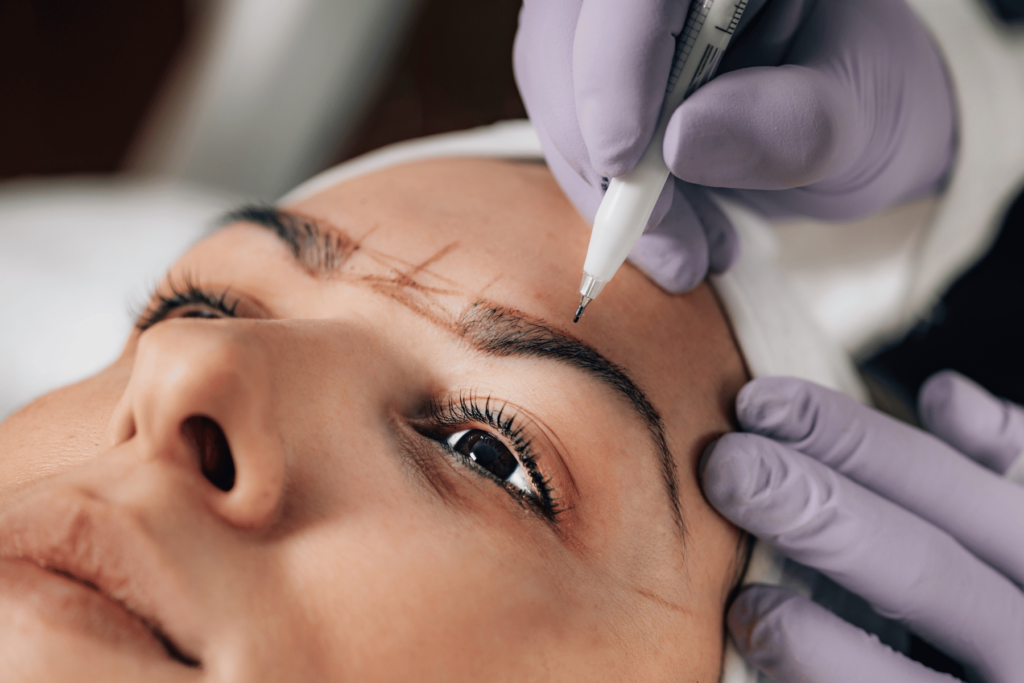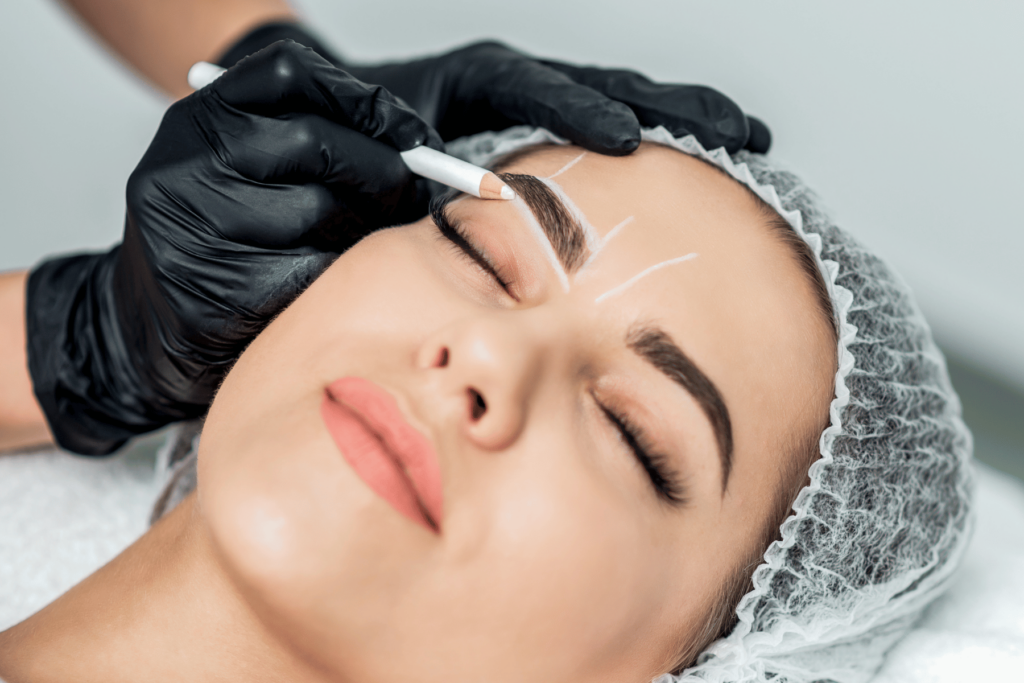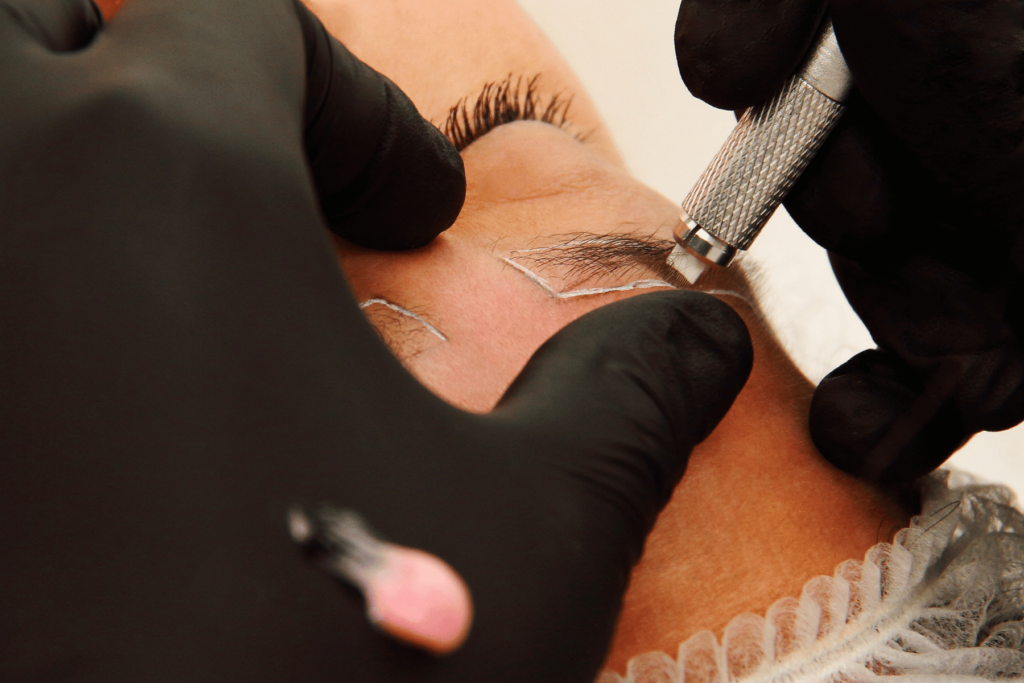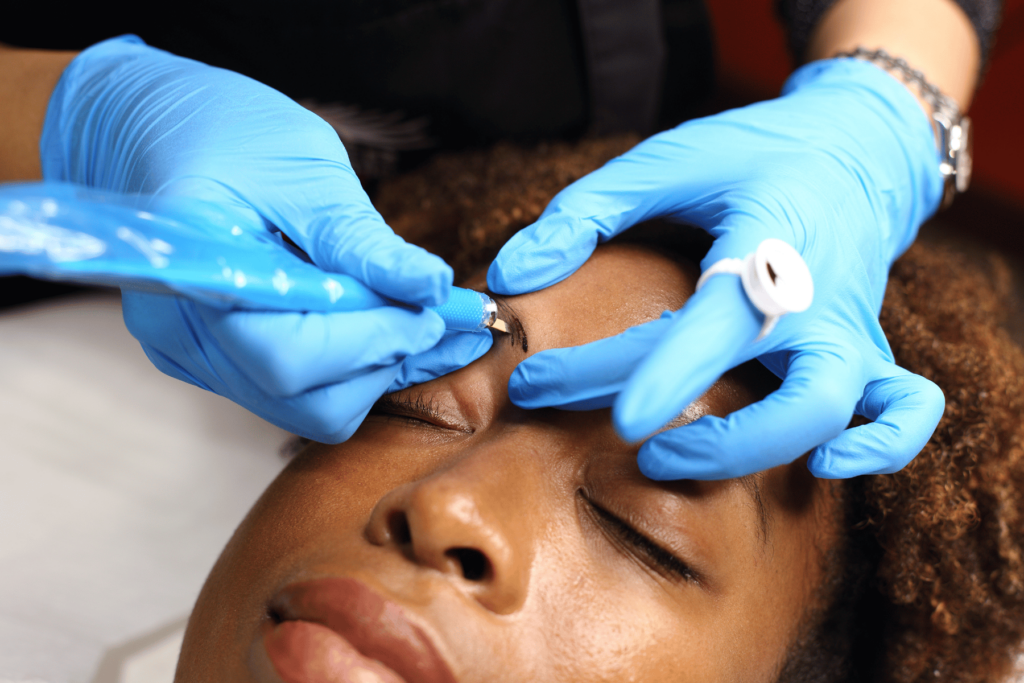Microblading has become an immensely popular beauty trend in recent years, offering a semi-permanent solution to sparse or uneven eyebrows.
Whether you’re tired of filling in your brows every morning or have lost hair due to medical conditions, microblading can be a game-changer.
However, for those with oily skin, there are unique considerations to keep in mind.
In this comprehensive guide, I’ll share whether microblading is effective on oily skin and include some important tips for achieving the best results for fuller brows.

What is Microblading?
Before we dive into the impact of oily skin on microblading, let me briefly explain what microblading is and how it works.
Microblading is a semi-permanent eyebrow tattooing technique that involves the use of a handheld tool to create tiny, hair-like strokes in the brow area.
The pigments used are deposited into the skin’s upper layer, providing a more natural and long-lasting appearance than traditional eyebrow makeup.
Ombre Brows
Ombre brows, sometimes referred to as “powder brows,” are a microblading technique that creates a soft and gradual shading effect, similar to the natural ombre transition from light to dark.
This technique is different from the traditional microblading method, which uses fine, hair-like strokes to mimic individual eyebrow hairs.
Instead, ombre brows involve the careful application of pigment in a way that results in a more shaded and powdered appearance.
Here are the key characteristics of ombre brows.
1. Soft Shading: Ombre brows are known for their soft, diffused appearance. The technique creates a gradual transition from a lighter shade at the front of the brows to a slightly darker shade toward the tail. This technique is particularly appealing to individuals who prefer a filled-in and shaded brow look.
2. Uniform Color: Ombre brows offer a consistent and uniform color throughout the brow, without the distinct appearance of individual hair strokes. The result is a more defined and polished appearance.
3. Enhanced Definition: Ombre brows are excellent for adding definition and shape to the eyebrows. They can make the brows look fuller and more symmetrical with a filled-in look, enhancing the overall facial appearance.
4. Longevity: Ombre brows tend to have a longer-lasting effect compared to traditional microblading because the pigment is deposited deeper into the skin. While microblading may require more frequent touch-ups, ombre brows can last longer before needing a touch-up.
5. Customizable: The ombre technique is highly customizable, allowing the technician to tailor the shading effect to the client’s preferences and face shape. Clients can discuss the desired intensity and shape of their ombre brows with their technicians.
Because I have oily skin, I get BOTH the traditional microblading done, followed up by the ombre brow treatment so they last longer.

Nano Brows
Nano brows, also known as “nanoblading,” are a relatively new and advanced technique in the world of eyebrow microblading.
Nanoblading involves using an even finer, nano-sized needle to create ultra-fine, precise hair-like strokes, which are thinner than those created through traditional microblading.
Nano brows offer several unique characteristics and benefits, including…
1. Ultra-Precision: The primary feature of nano brows is their level of precision for perfect eyebrows. The nano-sized needle allows technicians to create incredibly fine and natural-looking hair strokes that closely resemble real eyebrow hair. This technique is ideal for achieving a hyper-realistic, detailed appearance.
2. Subtle and Natural: Nano brows are perfect for those who desire a subtle and natural look. The fine strokes mimic the natural growth pattern of eyebrow hair, resulting in a soft, natural appearance. This technique is especially popular for individuals who want to fill in sparse areas or redefine their eyebrows without a noticeable “made-up” look.
3. Versatility: Nano brows can be used to enhance and refine eyebrows with different characteristics, whether you have naturally thin brows or simply want to improve your existing eyebrow shape and density.
4. Long-Lasting: Like traditional microblading, nano brows are semi-permanent and can last anywhere from 1 to 2 years, depending on factors such as your skin type and aftercare.
5. Minimal Discomfort: The fine, precise strokes created during a nano brow procedure often result in minimal discomfort for clients. Many technicians use numbing creams to ensure a painless experience.
If you have sensitive skin, you can use cream to numb the eyebrow area before the microblading session.

Does Microblading Work on Oily Skin?
Oily skin can pose some unique challenges when it comes to microblading.
Oily skin types tend to produce more sebum, the skin’s natural oil, which can affect how the pigments are retained and how long the results last.
Oily Skin and Microbladed Brows
1. Pigment Retention
Oily skin can lead to faster pigment fading than someone with a normal skin type or dry skin type.
Basically, it’s a problem holding on to color.
When you have oily skin, it’s like having a bit of a hurdle in the microblading race.
Your skin naturally produces more oil, and this excess oil can make the microblading pigment – the stuff that gives your microbladed brows their color – disappear a bit faster than if you had drier skin.
So, think of it as a race against time because you might need touch-up sessions sooner to keep your microbladed eyebrows looking vibrant and fresh.
2. Blurred Strokes
Now, picture this: your skin’s oil is like a smudge artist at work.
The extra oil can make those fine, hair-like microbladed strokes lose their sharpness and get a bit blurry over time.
And when your strokes lose their precision, it can mess with the overall look of your eyebrows.
3. Color Changes
Now, here’s where things get tricky with oily skin.
Your skin’s natural oil can play a bit of a color-changing trick on your microbladed brows.
Over time, the pigment’s color might decide to do a little dance and shift from its original intention.
This means your brows could end up looking somewhat muted or even take on a cooler tone.
So, if you were aiming for warm and vibrant, your brows might decide to go for a cooler, subtler look all on their own.
It’s like your brows have a mind of their own!

Tips for Successful Microblading on Oily Skin
While oily skin may present some challenges for microblading, there are steps you can take to ensure a successful outcome.
1. Choose an Experienced Technician
So, you’ve decided to take the plunge and get those gorgeous microbladed brows.
Now, the crucial question is, how do you find the right person for the job?
Here are some tips to help you discover an experienced microblading technician.
1. Ask for Recommendations: Start by asking friends or family who’ve had microblading done. They can share their experiences and recommend an experienced artist they trust.
If you’re close to Wellington, Florida, I can not recommend Josie at the Beauty and Brow Studio enough.
2. Check Online Reviews: Dive into the vast sea of the internet. Look for reviews on websites like Yelp, Google, or beauty-related forums. Reading about other people’s experiences can provide valuable insights.
3. Visit Social Media: Instagram and Facebook are great places to discover talented microblading artists. Many professionals showcase their work, allowing you to see their portfolio and style.
4. Consult with Beauty Salons: Reach out to local beauty salons or spas. They often have licensed microblading experts on staff or can point you in the right direction.
5. Ask for Certifications: Don’t be shy about asking potential technicians for their certification and training background. A qualified and experienced professional will be happy to share this information as a main skill set.
6. Schedule a Consultation: Before committing to the procedure, book a consultation. This is a fantastic opportunity to meet the technician, discuss your expectations, and see if you feel comfortable with them.
7. View Before-and-After Photos: Ask to see before-and-after photos of their previous clients. This will give you a clear idea of their skills and what you can expect.
8. Inquire about Aftercare: A good technician won’t just perform the procedure; they’ll also provide you with clear aftercare instructions to ensure your new brows look their best.
Remember, microblading is a semi-permanent procedure, so taking the time to find the right technician is worth the effort.
Your beautifully shaped and defined brows will thank you for it!

2. Follow Aftercare Instructions
Proper aftercare is essential to help your microblading results last longer.
This includes avoiding excessive sweating, sun exposure, and touching the treated area during the healing process.
More specifically…
1. Keep Them Dry: For the first 7-10 days after the procedure, avoid getting your brows wet. This includes keeping them dry during showers and avoiding swimming, saunas, and steam rooms.
2. No Touching: It’s tempting to touch and scratch your eyebrow area as they heal, but resist the urge. Touching them can introduce bacteria and disrupt the healing process.
3. Avoid Sun Exposure: Protect your freshly microbladed brows from direct sunlight. Sun can fade the pigment and cause discoloration. Use sunscreen if you’re heading out during the healing period.
4. Skip Makeup: Avoid applying makeup to your brows for at least a week or as recommended by your technician. Makeup can introduce bacteria and interfere with the healing process.
5. Avoid Excessive Sweating: Strenuous exercise and activities that make you sweat should be limited during the healing period. Sweat can push the pigment out of the skin.
6. No Scratching or Peeling: As your brows heal, they may scab or flake. Do not pick, scratch, or peel them. Let the scabs fall off naturally to avoid pigment loss.
7. Stay Hydrated: Drink plenty of water to help with the healing process. Hydrated skin tends to heal better.
8. Follow-Up Appointment: If a touch-up session is recommended by your technician (usually 4-6 weeks after the initial procedure), make sure to schedule and attend it. This helps ensure your brows look their best and last longer during the microblading healing process.
9. Avoid Certain Products: Be mindful of skincare products that contain acids or retinol around the brow area, as they can cause fading.
10. Expect Some Changes: Your brows may appear darker immediately after the procedure, but they will gradually lighten as they heal. Don’t be alarmed; this is normal.
Remember that the aftercare instructions may vary slightly depending on the brow technician and the specific products they use.

3. Use Oil-Control Products
Incorporate oil-control skincare products into your daily routine.
This can help manage the excess oil production and extend the life of your microblading results.
Here are some products and ingredients to add to your skincare routine for combatting oily skin and living with a little less shine.
1. Cleansers
Salicylic Acid Cleanser: This ingredient helps unclog pores and reduce oil production.
Glycolic Acid Cleanser: Exfoliates the skin, helping to control excess oil.
Charcoal Cleanser: Absorbs excess oil and impurities, leaving your skin feeling fresh.
2. Toners
Witch Hazel: A natural astringent that can help control oil production.
Niacinamide (Vitamin B3): Helps reduce sebum production and improve skin texture.
3. Serums
Hyaluronic Acid Serum: Balances hydration and can help regulate oil production.
Vitamin C Serum: Provides antioxidant protection and brightens the skin.
4. Moisturizers
Oil-Free Moisturizer: Lightweight and non-comedogenic, providing moisture without adding extra oil.
Mattifying Moisturizer: Formulated to control oil and shine throughout the day.
5. Sunscreen
Oil-Free, Non-Comedogenic Sunscreen: Protect your skin from UV damage without clogging pores.
In this guide about melasma, I share my favorite sunscreens.
6. Primer
Look for oil-free and mattifying primers that can help your makeup stay in place and control shine.
7. Setting Spray
A setting spray can help your makeup last longer and control oil.
If you want to use retinol or lactic acid, read this first.
Remember that everyone’s skin is unique, so it’s a good idea to consult with a dermatologist or skincare professional to determine the best products and routine for your specific needs.
When trying new products, introduce them gradually to make sure they don’t cause any adverse reactions, and always use products suitable for your skin type.
4. Schedule Touch-Up Sessions
A microblading touch-up session is an essential part of the microblading process that occurs a few weeks after your initial microblading procedure.
Here’s what typically happens during a microblading touch-up session:
1. Assessment: The session usually begins with the technician assessing your brows and how they’ve healed since the initial procedure. They’ll look for any areas where the pigment may not have retained well, where color might need adjustment, or where additional strokes are needed for a more defined look.
2. Color Adjustment: If necessary, the technician may make color adjustments based on how your skin has accepted the initial pigment. Pigment colors can slightly change during the healing process, so the touch-up allows for fine-tuning to achieve the desired result.
3. Enhancement: Any areas that need enhancement, additional strokes, or refinement are addressed during the touch-up. This includes making sure the hair-like strokes look crisp and natural.
4. Fill-In: The technician will fill in any gaps or areas where the pigment may not have held well. This ensures a uniform and natural appearance.
5. Aftercare Review: After the touch-up, your technician will provide you with updated aftercare instructions. It’s essential to follow these instructions to ensure the best healing and results from the touch-up session.
The timing of the touch-up session can vary, but it typically occurs around 4-6 weeks after the initial microblading procedure.
This allows the brows to heal and the pigment to settle before any necessary adjustments are made.
The touch-up ensures that your microbladed brows maintain their color, shape, and overall appearance for an extended period, often up to 1-2 years, depending on your skin type and aftercare routine.

Best Results for an Oily Complexion
Microblading can work on oily skin, but it does require special attention and care to ensure excellent results and perfect brows.
By choosing a skilled technician, following aftercare instructions, using oil-control products, and scheduling touch-up sessions, you can enjoy the benefits of beautifully shaped and defined eyebrows, even with oily skin.
If you have oily skin and are considering cosmetic tattooing, make sure to do your research and consult with a qualified professional to discuss your unique needs and expectations.
Let me know how your full brows are looking if you’re on the oilier side like me on social media. You can find me @ChristinaAllDay.
